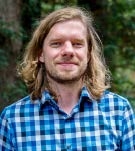
The Department of Physics in the J. William Fulbright College of Arts and Sciences presents the 2018 Robert D. Maurer Distinguished Lecture, "Discover of the First Electromagnetic Counterpart to a Gravitational Wave Source," by Ryan Foley, assistant professor at the University of California-Santa Cruz, at 7:30 p.m. Thursday, March 29.
His talk is free and open to the public, and will take place in Giffels Auditorium.
In 2015, scientists detected the first gravitational waves. This landmark discovery and new way of viewing the universe resulted in the 2017 Nobel prize. Then, on Aug. 17, 2017, a new kind of gravitational wave source was detected — two colliding neutron stars.
Professor Ryan Foley and his team found its aftermath, a kilonova, in optical light — the first detection of light from a gravitational wave source.
Examining the kilonova in detail, they then found that it produced large amounts of heavy elements — platinum and gold — that were shining brightly.
"This discovery heralds the start of a new scientific field, where we can combine gravity and light to understand the universe," Foley said.
About Ryan Foley: Foley received his B.S. in math, physics and astrophysics from the University of Michigan, and M.S. and Ph.D. degrees in astrophysics from University of California-Berkeley. He came to University of California-Santa Cruz from the University of Illinois in 2016. He has received the Clay Fellow at the Harvard-Smithsonian Center for Astrophysics, Sloan Research Fellowship, Packard Fellowship and Kavli Fellowship. More information about Foley's research can be found on the departmental website University of California Santa Cruz at astro.ucsc.edu.
About the Maurer Distinguished Lecture Series: The Maurer Distinguished Lecture Series began in 1995 in honor of Robert D. Maurer, distinguished alumnus of the Department of Physics. A native of Arkadelphia, Maurer received a doctorate from the Massachusetts Institute of Technology and was awarded an honorary Doctor of Laws degree from the University of Arkansas in 1980.
About the J. William Fulbright College of Arts and Sciences: The J. William Fulbright College of Arts and Sciences is the largest and most academically diverse unit on campus with 19 departments and 43 academic programs and research centers. The college provides the core curriculum for all University of Arkansas students and is named for J. William Fulbright, former university president and longtime U.S. senator.
Topics
Contacts
William J. Oliver III, professor and chair
Department of Physics
479-575-6571, woliver@uark.edu
Paula Prescott, fiscal support specialist
Department of Physics
479-575-5836, prescott@uark.edu